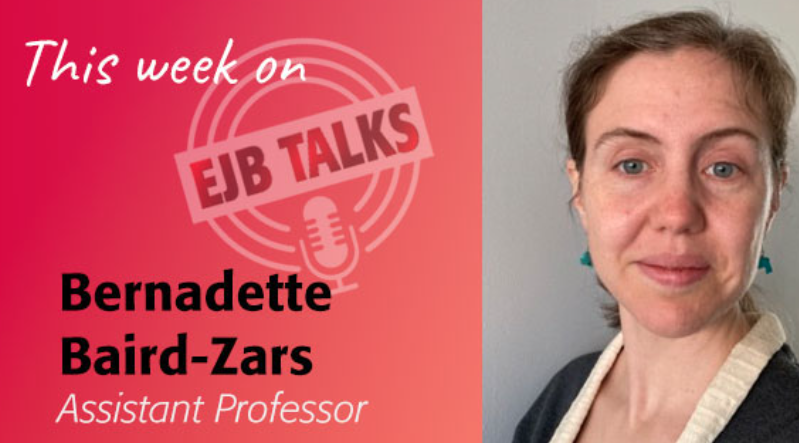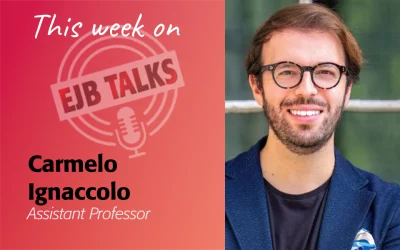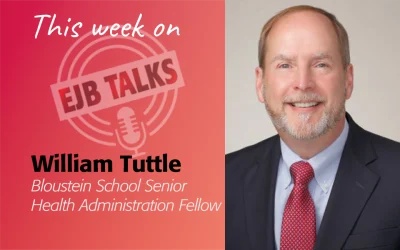Dean Stuart Shapiro interviews assistant professor Bernadette Baird-Zars, whose research interests span land use, governance, construction permitting, and the role of community-based organizations in reshaping planning processes. They discuss her interest in planning and how it works in practice, drawing from her experiences working on urban regeneration projects during her time living in Syria. Bernadette shares her observations about the gap between policy intentions and actions in planning, highlighting the complexities and unequal implementation of rules and systems. The conversation also touches on the concept of “gray institutions,” which refers to informal, daily practices in government offices that influence decision-making but are not explicitly documented or regulated. She explains how these gray institutions can exacerbate inequality and exclusion in policy processes. They conclude with a discussion of the challenges of public participation and the need for rethinking outdated participation structures, particularly in the context of climate change adaptation and coastal planning in New York and New Jersey.
Full transcript:
Stuart Shapiro
Welcome to EJB Talks. I’m Stuart Shapiro, the dean at the Bloustein School. The purpose of this podcast, now in its ninth season, is to highlight the work my colleagues and our alumni in the fields of policy, planning, and health are doing to make the world a better place.
This season, we’re starting with a couple of episodes focusing on some of our new faculty that we did not get to in the spring. And today I am speaking with Professor Bernadette Baird-Zars who is in her second-semester teaching, in our world-ranked Urban Planning program. Bernadette, welcome to the podcast.
Bernadette Baird-Zars
Thank you so much. I’m excited to be here. Happy to be at Bloustein.
Stuart Shapiro
Excellent. And we are thrilled to have you. A lot of your work is about planning, but also how we do planning. And I’m wondering how you got interested in that subject.
Bernadette Baird-Zars
Yeah, I think, through my work for sure, and learning and apprenticing and being told to do things that didn’t necessarily align with the stuff that was written down that we were supposed to do. And then so becoming interested in, “All right, why are we doing this?” And then what does that result in in practice? My first job out of college was at Lucky Lee in Aleppo, Syria doing historic kind of preservation in urban regeneration projects in the historic core. And I had — and that seems crazy, and I don’t know, far away — but really, I was lucky, because I was in a wonderful basement office with a team of really smart people trying to get things done amidst a swirl of institutional complication, literally, you know, around 6000 years of layers of stones on top of each other in history. And, you know, to put it mildly, a complicated political, macro situation.
The other reason I’m interested in how is just because I don’t know, the world doesn’t work like we want it to. Planners want it to be equal, efficient, and equitable. And nowhere where I grew up, or have lived really has been that way, it’s always been kind of on the edges of the law, or the edges of where resource allocation reaches. And so what causes that, you know, that kind of classic gap between policy desire and policy action? So that’s part of it.
Stuart Shapiro
And not only does it not work the way we want it to, but a lot of it doesn’t really work the way we think it does, either., in many cases. Often, I think the way academics or even I think the way public think the way it works.
Bernadette Baird-Zars
Yeah, I think, you know, the rules, obviously, that we make up aren’t implemented. The rules aren’t fair in the first place, the rules aren’t applied equally, and there’s a lot of arbitrariness, even when they’re applied with the best of intentions and values. And then there’s unequal knowledge about the rules and systems. I mean, I don’t know that’s one way of thinking about it. Another way is just irritating when you’re a planner, make beautiful plans, a lot of times implementation is stuck to the discussion section or the last page of your report. And, or the memo, it’s like, “We should consider how this might unfold in practice.” Or things might, you know, become complicated when unfolded in the municipal or at the municipal level. And that just struck me as leaving the big fun mystery, the interesting part for the last. Leaving it out, but not endogenizing it, or not putting it inside of how we consider what we want to do is how we want to do things.
Stuart Shapiro
Implementation will be challenging.
Bernadette Baird-Zars
Passive voice man, all the way.
Stuart Shapiro
Exactly. There’s no agency here.
Bernadette Baird-Zars
Yes.
Stuart Shapiro
That’s exactly right. So when were you in Aleppo?
Bernadette Baird-Zars
I started living there, and I moved there for about two and a half years between 2006 and 2008. And then I went back multiple times a year, until 2011.
Stuart Shapiro
Until the civil war.
Bernadette Baird-Zars
Yes.
Stuart Shapiro
Now, you’ve also been to a bunch of other places, I think that have probably informed your trajectory. Can you talk a little bit about one or two more experiences you had before sort of committing to academia?
Bernadette Baird-Zars
I don’t know if I have committed to academia, Stuart. (laughing)
Stuart Shapiro
I’m being optimistic here! (laughing)
Bernadette Baird-Zars
(laughing) Just joking. No, I am so incredibly lucky to be in a place where I can ask these kinds of questions and talk with somebody like you and all of my colleagues here. After doing my master’s in urban planning, an excellent degree that Bloustein offers, and is one of the top programs in the nation, I should say.
Stuart Shapiro
(laughing) Thank you for that!
Bernadette Baird-Zars
And it’s really applicable across multiple forms of policy, of work, of activism, of moving in land and housing and health. I think that a lot of folks are interested in it. So it doesn’t have to be you know, you’re not just drawing sidewalks. You’re trying to fix really complex, understand how to intervene in really complex problems. Okay, I’ll stop being a teacher and a plug.
I think I started working on housing finance projects, and in particular housing upgrade finance to kind of link some sources of global or American money to entities making microfinance loans. And that was really interesting and really complicated. But I learned a lot more about the world of money, and interest rates and how things that seem very fancy from a distance, may actually be made by a 25-year-old, actually making calculations on a napkin, and that was me at the time. (laughing)
And so that was one kind of topical place that I think I learned a lot about kind of the money that goes into lending into urban property markets. And also the types of ways that people talk about development. Then after that, I worked as a consultant for the World Bank, for the IDB, for Habitat for Humanity, for some national governments, mainly on housing policy, and also on land and urban policy. And so I’d say, geographically, the places where I’ve actually spent the most time and lived for multiple years, are Mexico and Syria, those are the two places where I can confidently cook the food and offer it up and people will be impressed. I’m learning increasingly more about New York and New Jersey. And so that’s something important to me.
Stuart Shapiro
So let me turn to your research a little bit now so we can give the audience a flavor of that. You talk about gray institutions. And I was wondering if you could explain what you mean by that.
Bernadette Baird-Zars
I think of gray institutions as the patterns of daily practice that we construct with other people. And so I got into this or became interested in this really, by sitting in zoning offices and land use offices in Mexico for a long time and watching how folks were deciding what to implement and what to do. And the things that they decided to do, and the tools that they made and the practices that they enacted, like checklists, like forms on Excel sheets, like archives, like always saying, “Oh, you should go back and check your water permit” if it was above a certain aquifer, but not another. Like weekly prioritization meetings. They’re always there, you can count that they’ll happen, but they’re not written down anywhere. They’re not told to them, and they’re not breaking any laws, either.
Stuart Shapiro
So when we have these gray institutions, can you elaborate a little bit on how they exacerbate inequality? I think that is what you said or “leave people out,” if you will, and/or to some degree, are they sometimes things that just sort of emerge organically to cope with rules or laws that don’t make sense or that have problems?
Bernadette Baird-Zars
Yeah. Something that’s on my mind right now is flood mitigation and adaptation for climate change around New York and New Jersey. And as you probably know, there is a $56 billion project around the New York New Jersey Harbor, from the Army Corps of Engineers. The kind of informal, yet entrenched ways of working and setting up–for example, the public comment period–pretty much systematically exclude anyone who is not like me. Anyone who’s not already on an email list and obsessed with it can take time out of their day, two days in advance to dial in or to go show up at a public meeting on Tuesday afternoon at 2 p.m. All of the comments are taken individually. And from what I understand — and I admit my country is somewhat foreign to me — but this is really standard process for a lot of state and federal agencies, that you receive public comments individually, that they’re made, that they’re circulated and promoted in relatively hard to access ways to some extent.
And so what this is resulting in is absolutely unconscionable. exclusionary policy, I think, in which the metrics that will determine where and which communities receive walls and other forms of protection against storm surge are determined almost exclusively on property value, and not the number of people that live there. And, by the squeaky wheels who make comments one the comments, and in the public comments. And so those forms of — this is not the fault of anyone who works there — right, necessarily? It is not the fault of the regulations necessarily, although both contribute to it. But it gels and reproduces through and kind of compounds — to borrow my colleague Andrea Restrepo-Mieth’s term — through, I would argue, these ways of working.
Stuart Shapiro
Right, you know, we can easily go down a public comment rabbit hole here, because it’s something I’m very interested in, and have been throughout. I will note that the Biden Administration last year, or maybe earlier this year, or last year did a number of open houses on how to facilitate participation, and how to get comments and feedback from a broader public than those that usually comment on rulemakings. And I think there’s a lot of great ideas coming out of that. At its heart, I worry a little bit though, that — maybe worry really is not even the right word — but maybe it’s with age growing to accept, that to some degree, people have more important things to do with their lives, right? And, you know, if you’ve got to put food on the table, and you have to get to work and get the kids off to school, and all of those things, and, you know, you work X number of hours a week to do that. You know, commenting and such, you know, part of it putting faith in others to comment for you, even if those are somewhat elites is maybe not the worst thing in the world. And it’s, you know, those are more so the thoughts that go around in my head than anything I’ve written about it, but it is, I think, a question that we need to think about.
Bernadette Baird-Zars
Oh, 100%, that’s been on my mind, too. And I’m new to looking at the U.S. structures of participation to some extent. But I think it’s really clear. And I’ve heard this now in the last couple of weeks, from several people in different eloquent ways, and have come to my own conclusion. These structures are just incredibly outdated, and we need to rethink the entire apparatus. I mean, why is it that comments are expected, that the onus of time and energy to learn is placed on individualism, without any assumption that they might be part of setting up the questions, right? Or that they might have knowledge instead of just comments.
So I think, you know, the institutions of participation that we’ve inherited, came out of really interesting and good moments. Some in the 1960s, right? That tried to get more voices inside of politics or inside of policy-making or doing, but they were deeply flawed. And the fact that we haven’t taken a big systemic radical relook at them, is problematic. And so when little, I say, you know, well-meaning efforts like by the Biden administration, to think about how to do things differently, which I would argue without looking at actually how people are doing them now and why they’re doing them, why teams of the Army Corps keep, you know, putting out the email to the same people that they do always to invite for public comment? Then you’re not actually going to be able to change things. So it needs to be formal, along with gray — along with informal– along with just yeah, big change.
Stuart Shapiro
So do you see your research focusing more on the U.S. now? What directions do you see your research going?
Bernadette Baird-Zars
I think geographically, I hope to add the U.S. and in particular, New York and New Jersey and coastal adaptation, which is something I’ve been working on now for almost two years as part of my portfolio of really bigger questions of how to understand local government efforts to change land use, involve people, adapt to climate change. Inside of, you know, state, federal, and international systems. There are a lot of similarities across geographies in the ways that people have and make big climate plans or big disaster plans, and then they don’t happen. Or sorry, those priorities are unfunded, or they’re not shared by the local government, or, you know, they have big opposition that they haven’t endodgenized, etc. So how, or you know, the construction code and zoning code go completely against it? So one part is kind of more technical, and I enjoy getting into the weeds of land use, and construction permits, and those sorts of things.
And another part is kind of more about governance and institutions. And I think those also have similarities to some extent in other geographies where I’m working. I have one ongoing project and I’m involving two Bloustein undergrads. Well, one’s a Rutgers undergrad in civil engineering, actually, on construction permitting and flooding in both the Guadalajara metropolitan area and coastal and riverine New Jersey or municipalities that are with high flooding risk in New Jersey. And so we’re using construction permits as kind of as one of the signals of government, of institutional processes that we can look at, to kind of back solve for how are decisions actually being made in practice, as opposed to looking at the plans from the top down. Here are the goals we have and what’s being implemented. Actually looking at what are the signals we can pick up from the ground to understand how policies are being enacted. So that’s one answer to the geography, I think.
Another part is, through the immersion with community-based organizations and in environmental justice alliances in New York and New Jersey in the past two years, I’ve become much more interested in the ways that formal planning processes can shift to radically not just put more seats at the table, but change how the table is designed, and who’s invited to sit there. And who does the inviting, and who decides if it’s even a table after all? And most importantly, if there’s food on that table. But I’m, I’m right now, I’m still really interested in the in-government processes, and the day-to-day of bureaucrats is my bread and butter.
Stuart Shapiro
Well, you have a very target-rich environment and a fascinating area to look at. Thank you so much for coming on the podcast, Bernadette.
Bernadette Baird-Zars
Thank you, Stuart. It’s really a pleasure to be here. I know you asked many of these questions too, so I’m going to follow up with lots of questions for you.
Stuart Shapiro
Excellent, excellent. A big thank you also to Tamara Swedberg and Karyn Olsen for their help in producing the podcast. We will see you next week with another talk from another expert at the Bloustein School. Until then, stay safe.




